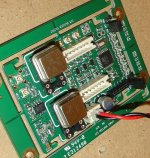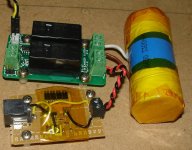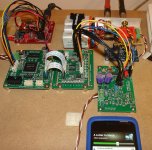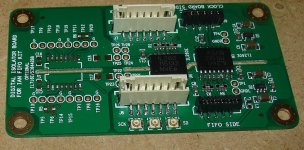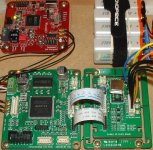I had a working FIFO and 2x clock board (stock clocks), powered by the FIFO. I put together the isolator and the battery management board and removed the two regulators from the 2x clock board. Now I get no sound out of the device.
I removed the FIFO assembly and tested the dac board straight to the usb board and I get sound, so it's not the usb or dac boards. I removed the isolator and battery management boards and replaced the 2x clock board for the Si570 and single clock boards and still get no sound.
The battery management board I checked and it works fine when turning the control 5vdc on/off, it either feeds the battery output or shuts it off. When it shuts off the charger feeds the battery. Is there any way of testing the FIFO board itself for correct operation? The isolator board? It seems I've damaged the FIFO board?
I've attached photos of the isolator, 2xclock and battery manager. FIFO with Si570 hooked up and music streaming but not "playing" (i.e., no sound). The isolator has nothing soldered to the bottom side.
Thanks in advance for any help!
I removed the FIFO assembly and tested the dac board straight to the usb board and I get sound, so it's not the usb or dac boards. I removed the isolator and battery management boards and replaced the 2x clock board for the Si570 and single clock boards and still get no sound.
The battery management board I checked and it works fine when turning the control 5vdc on/off, it either feeds the battery output or shuts it off. When it shuts off the charger feeds the battery. Is there any way of testing the FIFO board itself for correct operation? The isolator board? It seems I've damaged the FIFO board?
I've attached photos of the isolator, 2xclock and battery manager. FIFO with Si570 hooked up and music streaming but not "playing" (i.e., no sound). The isolator has nothing soldered to the bottom side.
Thanks in advance for any help!
Attachments
I had a working FIFO and 2x clock board (stock clocks), powered by the FIFO. I put together the isolator and the battery management board and removed the two regulators from the 2x clock board. Now I get no sound out of the device.
I removed the FIFO assembly and tested the dac board straight to the usb board and I get sound, so it's not the usb or dac boards. I removed the isolator and battery management boards and replaced the 2x clock board for the Si570 and single clock boards and still get no sound.
The battery management board I checked and it works fine when turning the control 5vdc on/off, it either feeds the battery output or shuts it off. When it shuts off the charger feeds the battery. Is there any way of testing the FIFO board itself for correct operation? The isolator board? It seems I've damaged the FIFO board?
I've attached photos of the isolator, 2xclock and battery manager. FIFO with Si570 hooked up and music streaming but not "playing" (i.e., no sound). The isolator has nothing soldered to the bottom side.
Thanks in advance for any help!
Hi Palmito,
Please check three LED indicators on the FIFO board,
1. If all LED are off, that means the problem is from the the isolaror board or clock board.
2. If Empty LED is on, it means input I2S signal has problem
3. If Lock LED is on, that means FIFO works fine, you should get sound.
If you are in case 1, try to run the system without isolaor to see if it is working(do not power clock board from DC input for this configuration)
Good luck,
Ian
Hi Palmito,
Please check three LED indicators on the FIFO board,
1. If all LED are off, that means the problem is from the the isolaror board or clock board.
2. If Empty LED is on, it means input I2S signal has problem
3. If Lock LED is on, that means FIFO works fine, you should get sound.
If you are in case 1, try to run the system without isolaor to see if it is working(do not power clock board from DC input for this configuration)
Good luck,
Ian
I noticed you have already removed the regs from the clock board, in this case, you can't power the clock board from FFC/FPC calbe from FIFO, 5V may damage the clock board.
If you want to run the system without isolator board, you and use single clock board to play 44.1K music.
After you address the problem, you can go ahead what ever you want.
Ian
I had a working FIFO and 2x clock board (stock clocks), powered by the FIFO. I put together the isolator and the battery management board and removed the two regulators from the 2x clock board. Now I get no sound out of the device.
I removed the FIFO assembly and tested the dac board straight to the usb board and I get sound, so it's not the usb or dac boards. I removed the isolator and battery management boards and replaced the 2x clock board for the Si570 and single clock boards and still get no sound.
The battery management board I checked and it works fine when turning the control 5vdc on/off, it either feeds the battery output or shuts it off. When it shuts off the charger feeds the battery. Is there any way of testing the FIFO board itself for correct operation? The isolator board? It seems I've damaged the FIFO board?
I've attached photos of the isolator, 2xclock and battery manager. FIFO with Si570 hooked up and music streaming but not "playing" (i.e., no sound). The isolator has nothing soldered to the bottom side.
Thanks in advance for any help!
Both FIFO and clock boards are fully tested. So I suspect the isolator board is the criminal
You should have the schematic, most probably is the resistor packs, try to find if there is any short or disconnect under the chip.
Ian
Hi Joseff,
FIFO is a bit-perfect system, if you have something changed on volume, it should be a system problem. I suggest you checking the signals from DSP to see if it is standard I2S.
To address this issue, you can try FIFO in SPDIF in, SPDIF out mode (SPDIF FIFO configuration), if the volume keeps as same as input without low volume problem on your DAC, that means the problem is the signals from DSP.
Another thing I want to mention is that, FIFO improves sound quality by better clock. I don't know what XO you are using right now. FIFO will be meaningless if you don't have a really nice low jitter clock and good power supply for it.
Please let me know your result.
Regrds,
Ian
Hi Ian,
I configured the FIFO in SPDIF in, SPDIF out mode as you suggested. It works very well, the sound is perfect and the sound level is normal. I have checked the connection to the servo again but there is nothing wrong. So there is anything wrong in the circuit around the servo.
Many thanks to you!
Regards, Josoeff
f you want to run the system without isolator board, you and use single clock board to play 44.1K music.
I set it up with the 1xclock, which I have never used with the isolator/battery manager, so it shuold not be damaged. Fed it 44.1 music. I tried both with the long cables and the u.fl cables in case I mistakenly broke one of the long cable connectors pulling things out. No sound from either set of cables.
Attached is a photo, the only led lighted on the FIFO board is the power one.
I suggest a load testing procedure for the battery board + isolator board be added to the manual; before connecting fifo (500Ω-1KΩ power resistor or something). this will give time to eliminate it as a suspect before adding the fifo into the mix.
That's a great idea qusp. It would help out us less knowledgeable folks to do "unit testing" before deploying...
I'll put myself down for *two* FIFO boards for the next group buy, I hope there is one...
Attachments
I set it up with the 1xclock, which I have never used with the isolator/battery manager, so it shuold not be damaged. Fed it 44.1 music. I tried both with the long cables and the u.fl cables in case I mistakenly broke one of the long cable connectors pulling things out. No sound from either set of cables.
Attached is a photo, the only led lighted on the FIFO board is the power one.
That's a great idea qusp. It would help out us less knowledgeable folks to do "unit testing" before deploying...
I'll put myself down for *two* FIFO boards for the next group buy, I hope there is one...
Hi palmito,
I saw the XO is at wrong position from the picture of your single configuration.
Please see the fifo picture with sinale xo below for details:
http://www.diyaudio.com/forums/grou...-pdif-fifo-kit-group-buy-104.html#post3372689
Please note pin1 of XO has to face the 45 degree corner of the xo footprint.
I believe you can fix it.
Ian
I've done some extensive comparisons between the si and dual xo with crystek 957 22/24 mhz boards using the spidf/aes board as output.
The si570 board cannot be used to output 176/192 khz on spdif in my case since itll run 45/49 mhz on its lowest group setting, so when using the si570 I downsample those to 88.2/96 khz in software (doesnt seem to have much if any negative impact on sound).
I have a preference for not using the isolator board with both clock boards, it sounds better to me without, its advantage may be nullified by the spdif board being powered from the fifo board.
I'm using Sjostrom superregulators to power waveio/fifo with fully seperated clc powersupplies. The powersupply has a very large impact on the sound, quite surprised by how much for basically a D/D converter! I have tried nichicon muse, panasonic fc, mundorf ag, elna silmic 2, they all sound quite different, also interesting that clc sounds better then c before the sjostrom superreg (cleaner/more LF impact), even copper or silver wiring in the powersupply is audible, I can offer no explanation for this, I've gone back and forth numerous times over several weeks and have had friends over to make sure I was not imagining things..
The dual crystek setup sounds significantly better in my system. Cleaner, clearer, more/finer detailed, better soundstaging, tighter more powerfull lows/more impact. The Si570 has some midrange sweetness that may be appealing to some. Its been powered with the supplied 3,3v reg though in all cases with a sjostrom prereg when using the isolator board (only have 5/6V sjostrom superregs available).
Now FWIW because for a totally fair comparison I should power the si570 with a sjostrom 3.3v supperreg which I havent tried yet. Oh I'm fully aware the si570 was developed for 90/98 mhz duties so again this comparison is only valid for 22/24MHz duties.
A final note, the fifo improves the sound from the waveio quite considerably, even when feeding a hypex dlcp which resamples/reclocks everything again anyway, good stuff!!
The si570 board cannot be used to output 176/192 khz on spdif in my case since itll run 45/49 mhz on its lowest group setting, so when using the si570 I downsample those to 88.2/96 khz in software (doesnt seem to have much if any negative impact on sound).
I have a preference for not using the isolator board with both clock boards, it sounds better to me without, its advantage may be nullified by the spdif board being powered from the fifo board.
I'm using Sjostrom superregulators to power waveio/fifo with fully seperated clc powersupplies. The powersupply has a very large impact on the sound, quite surprised by how much for basically a D/D converter! I have tried nichicon muse, panasonic fc, mundorf ag, elna silmic 2, they all sound quite different, also interesting that clc sounds better then c before the sjostrom superreg (cleaner/more LF impact), even copper or silver wiring in the powersupply is audible, I can offer no explanation for this, I've gone back and forth numerous times over several weeks and have had friends over to make sure I was not imagining things..
The dual crystek setup sounds significantly better in my system. Cleaner, clearer, more/finer detailed, better soundstaging, tighter more powerfull lows/more impact. The Si570 has some midrange sweetness that may be appealing to some. Its been powered with the supplied 3,3v reg though in all cases with a sjostrom prereg when using the isolator board (only have 5/6V sjostrom superregs available).
Now FWIW because for a totally fair comparison I should power the si570 with a sjostrom 3.3v supperreg which I havent tried yet. Oh I'm fully aware the si570 was developed for 90/98 mhz duties so again this comparison is only valid for 22/24MHz duties.
A final note, the fifo improves the sound from the waveio quite considerably, even when feeding a hypex dlcp which resamples/reclocks everything again anyway, good stuff!!
Thanks again Ian. I placed it correclty now. I never used the 1xclock board until now to test the system after it stopped playing and I don't remember ever pulling the XO out (but good memory is not a trait I have). I did pull the XO's out of the 2xclock board when removing the regulators, but I placed those back correctly.I saw the XO is at wrong position from the picture of your single configuration.
But it didn't help, I still get no sound and only the power led on in the FIFO board.
Back to waiting for the next group buy...
Thanks again Ian. I placed it correclty now. I never used the 1xclock board until now to test the system after it stopped playing and I don't remember ever pulling the XO out (but good memory is not a trait I have). I did pull the XO's out of the 2xclock board when removing the regulators, but I placed those back correctly.
But it didn't help, I still get no sound and only the power led on in the FIFO board.
Back to waiting for the next group buy...
Hi palmito,
In this case, please sent them back to me, I can address what was the problem. I don't know how long it will take for you to get the new board from next GB.
When you do so, please don't forget including a small piece of paper with your shipping address, your email, your DiyAudio ID ,your order number and some note about the problem. Thanks.
Regards,
Ian
Last edited:
In this case, please sent them back to me, I can address what was the problem.
Thanks a lot Ian. I will send it out tomorrow.
even copper or silver wiring in the powersupply is audible,
You about the primary or secondary stage?both?
With 6V input to the FIFO, why would I get 6V at J5 (5V output).
Wanting to use J5 to power the isolated I2S outputs on WaveIO (5V), glad to have measured first!. Can trim FIFO's DC input back to 5V (and then have 5V also at J5) but wondering firstly if J5 is supposed to have 5V with when the FIFO is powered with 6V, or if J5 simply equals the voltage at the input to the FIFO.
Thanks,
Shane
Wanting to use J5 to power the isolated I2S outputs on WaveIO (5V), glad to have measured first!. Can trim FIFO's DC input back to 5V (and then have 5V also at J5) but wondering firstly if J5 is supposed to have 5V with when the FIFO is powered with 6V, or if J5 simply equals the voltage at the input to the FIFO.
Thanks,
Shane
With 6V input to the FIFO, why would I get 6V at J5 (5V output).
Wanting to use J5 to power the isolated I2S outputs on WaveIO (5V), glad to have measured first!. Can trim FIFO's DC input back to 5V (and then have 5V also at J5) but wondering firstly if J5 is supposed to have 5V with when the FIFO is powered with 6V, or if J5 simply equals the voltage at the input to the FIFO.
Thanks,
Shane
Hi ceglar,
The DC output is just after a CLC filter from input, that's why it's a bit lower than the input. Both clock board and spdif board, as well as isolator board have own regulator. You can power FIFO from a 5V DC input without any problem.
ian
I've done some extensive comparisons between the si and dual xo with crystek 957 22/24 mhz boards using the spidf/aes board as output.
The si570 board cannot be used to output 176/192 khz on spdif in my case since itll run 45/49 mhz on its lowest group setting, so when using the si570 I downsample those to 88.2/96 khz in software (doesnt seem to have much if any negative impact on sound).
I have a preference for not using the isolator board with both clock boards, it sounds better to me without, its advantage may be nullified by the spdif board being powered from the fifo board.
I'm using Sjostrom superregulators to power waveio/fifo with fully seperated clc powersupplies. The powersupply has a very large impact on the sound, quite surprised by how much for basically a D/D converter! I have tried nichicon muse, panasonic fc, mundorf ag, elna silmic 2, they all sound quite different, also interesting that clc sounds better then c before the sjostrom superreg (cleaner/more LF impact), even copper or silver wiring in the powersupply is audible, I can offer no explanation for this, I've gone back and forth numerous times over several weeks and have had friends over to make sure I was not imagining things..
The dual crystek setup sounds significantly better in my system. Cleaner, clearer, more/finer detailed, better soundstaging, tighter more powerfull lows/more impact. The Si570 has some midrange sweetness that may be appealing to some. Its been powered with the supplied 3,3v reg though in all cases with a sjostrom prereg when using the isolator board (only have 5/6V sjostrom superregs available).
Now FWIW because for a totally fair comparison I should power the si570 with a sjostrom 3.3v supperreg which I havent tried yet. Oh I'm fully aware the si570 was developed for 90/98 mhz duties so again this comparison is only valid for 22/24MHz duties.
A final note, the fifo improves the sound from the waveio quite considerably, even when feeding a hypex dlcp which resamples/reclocks everything again anyway, good stuff!!
Hi edbk,
Thank you so much for sharing your experience with us. It seems you did good job on research and went through a lot of combinations.
I'm sorry for my late reply, I was busy working at a testing lab to fix a 900MHz EMC problem last week.
Yes, with FIFO, we can have a lot of new discovery on digital audio, it's really a good stuff for our audiophiles.
Si570 clock board was not designed for spdif board, it's running at double speed mode. You can try connecting the MCLK from the u.fl connector on the FIFO board to the spdif board to support full Fs range, but the problem is you will degrade the MCLK quality in this case. If it is possible, I suggest you try I2S output for different MCLK and *Fs combination.
I'm interested in the CLC filter and the sjostrom prereg you mentioned. Can you show some thing more to us about them?
Regards,
Ian
Ian, I probably have a spare sjostrom reg PCB around here somewhere you can have if you want. its basically a jung superreg
Thanks qusp, yes, I'm interested in the PCB. I'd like to give a try if you have.
Regards,
Ian
Hi ceglar,
The DC output is just after a CLC filter from input, that's why it's a bit lower than the input. Both clock board and spdif board, as well as isolator board have own regulator. You can power FIFO from a 5V DC input without any problem.
ian
Thank you, Ian. Much appreciated and I look forward to your PCM board as well !!
Regards,
Shane
Hi edbk,
I'm interested in the CLC filter and the sjostrom prereg you mentioned. Can you show some thing more to us about them?
Regards,
Ian
As qusp said the sjostrom is based on the jung superreg, modified to use smd parts. It has a small footprint. It was tested in Linear Audio Magazine vol.4. I really like them obviously.
Its PSRR was something like -120 dB at 10Hz and -80dB at 1MHz from memory so could be off a little. So maybe the L helps to improve things in the MHz range?
I'm currently running 60VA toroid - Cree Sic Schottky's - Mundorf AG47mF - a modified lundahl ll2733 choke (DCR 3,4 Ohm/460mH) - Mundorf AG47mF - Sjostrom reg on both waveio and fifo
Removing the choke on the FIFO ps makes the highs more agressive/harsh but the most noticable is its a lot "quieter/more relaxed" and the LF impact is considerably higher + more controlled.
Difference on the WAVEIO seems minimal.
Calculating from voltage drop the WAVEIO draws around 350mA max and the FIFO/dual clock board 150 mA.
Next on my to try list is Choke input, LCLC with a mundorf ag/elna silmic mix, but I need to purchase a different transformer for that first.
- Home
- Source & Line
- Digital Line Level
- Asynchronous I2S FIFO project, an ultimate weapon to fight the jitter
